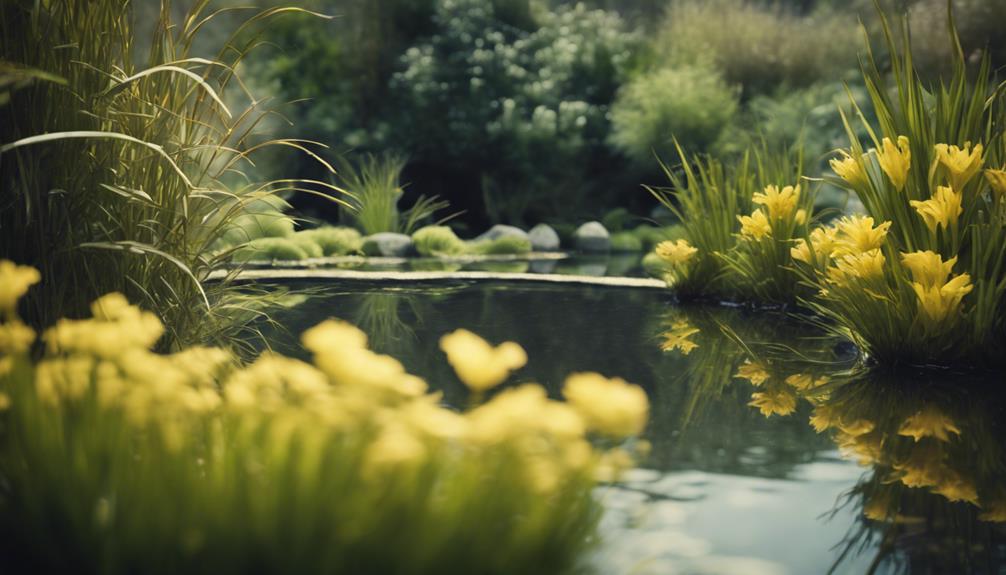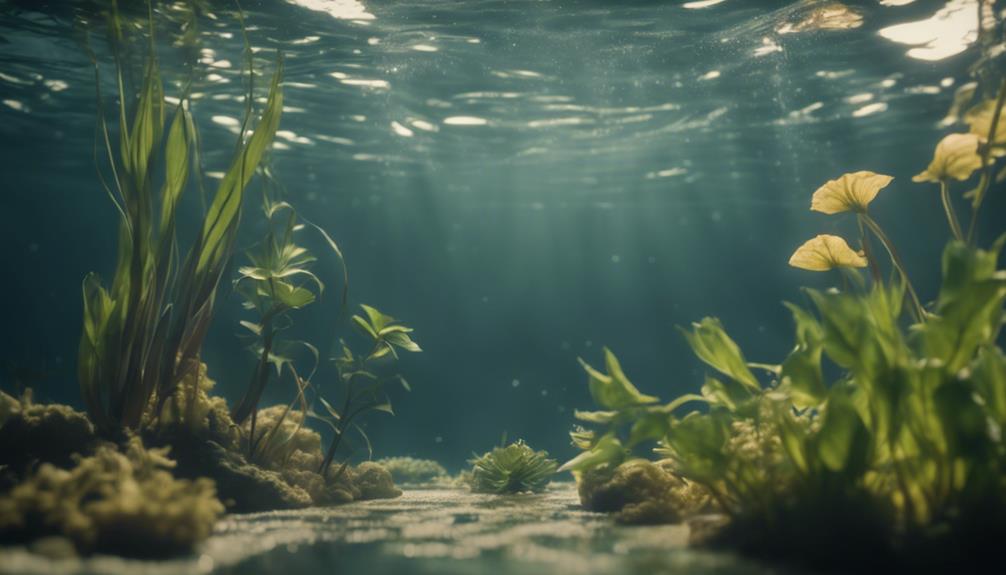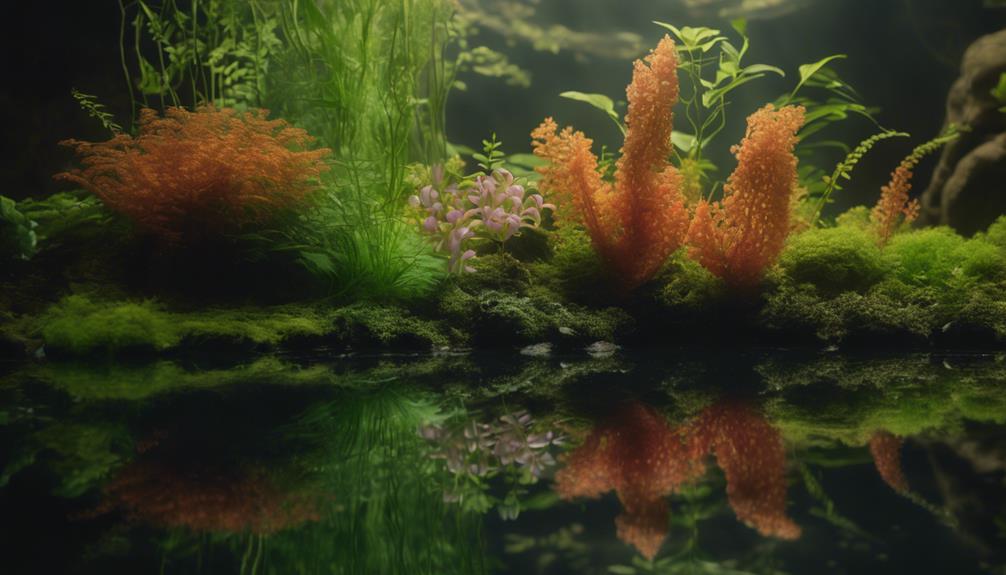You've chosen a shady spot for your aquatic oasis, but don't worry – there are superstar plants that'll thrive in low-light conditions! For bog areas, Marsh Marigold, Bog Bean, Water Hawthorne, Lizards Tail, and Cardinal Flower are perfect. They'll excel in moist soil and partial shade. Water Lettuce and other floating plants provide shade, absorb excess nutrients, and regulate water temperature. Marginal plants like Marsh Marigold and Bog Bean offer filtration and beauty. Deep emergent plants add visual interest, while submerged plants like Hornwort and Cabomba oxygenate and maintain water quality. Now, discover how to combine these plants to create a thriving, balanced ecosystem.
Table of Contents
Key Takeaways
- Marsh Marigold and Bog Bean thrive in shady areas with moist soil, producing yellow and white flowers, respectively.
- Water Lettuce and other floating plants provide shade, shelter, and absorb excess nutrients, creating a balanced ecosystem.
- Cardinal Flower, Lizards Tail, and Water Hawthorne add late-season color and filtration to aquatic landscapes with partial shade to full sun.
- Deep emergent plants like Heart-shaped leafed plants add texture, variety, and vertical interest to ponds in partial shade.
- Submerged plants like Hornwort, Cabomba, and Anacharis thrive in low-light conditions, producing oxygen and maintaining water quality.
Bog Plants for Shade
When creating a shaded aquatic garden, you'll want to incorporate bog plants that thrive in low-light conditions, such as Marsh Marigold, Bog Bean, Water Hawthorne, Lizards Tail, and Cardinal Flower, which have adapted to flourish in these environments.
These plants have evolved to excel in shady areas with moist soil, making them perfect for your aquatic oasis.
Marsh Marigold, for instance, grows 1-2 feet tall with heart-shaped green foliage and clusters of yellow flowers, thriving in moist soil.
Bog Bean, on the other hand, spreads horizontally across the water with thick, woody rhizomes, sending up leaves and delicate white flowers in shaded conditions.
Water Hawthorne grows from a small bulb, preferring cool, shaded water and producing lovely white flowers and oval-shaped green foliage.
Lizards Tail and Cardinal Flower add late-season color with white patches on green foliage and attractive flowers, tolerating partial shade and moist soil.
Floating Plants for Coverage
As you've curated a lush selection of bog plants for your shaded aquatic garden, now it's time to turn your attention to floating plants that provide coverage, which won't only add visual interest but also help regulate water temperature and reduce algae growth.
These shade-tolerant pond plants are essential for creating a balanced ecosystem in your water gardens.
Floating plants like Water Lettuce are perfect for shady areas, as they thrive in low-light conditions and provide shade and shelter for aquatic life.
They play a vital role in maintaining a healthy environment by absorbing excess nutrients and preventing algae blooms.
By incorporating floating plants into your design, you'll create a natural-looking habitat that supports biodiversity.
Plus, they're easy to care for and require minimal maintenance.
With the right selection, you'll be able to enjoy a thriving and resilient aquatic ecosystem that flourishes in shady areas.
Marginal Plants for Filtration

Your search for marginal plants that excel at filtration leads you to a diverse group of species, each with unique characteristics and benefits that enhance the overall health of your aquatic ecosystem.
These plants thrive in partial shade to full sun, making them perfect for ponds and water features with varying levels of shade.
Marsh Marigold, with its heart-shaped green foliage and bright yellow flowers, is a popular choice. Bog Bean, with its thick, woody rhizomes and delicate white flowers, is another excellent option. Cardinal Flower, Lizards Tail, and Water Hawthorne are also great choices, each offering distinct features and benefits.
These marginal plants not only provide filtration but also add beauty and diversity to your aquatic landscape. They're well-suited for ponds and water features with partial shade to full sun, and their green foliage and flowers will add a pop of color to your outdoor space.
Deep Emergent Plants for Beauty
Among the most visually stunning aquatic plants, deep emergent plants are particularly striking, with their tall stems and vibrant flowers rising above the water's surface to create a breathtaking display of color and texture.
You can add these plants to your shaded pond to create a beautiful, thriving ecosystem. One popular option is the heart-shaped leafed plant, which grows well in partial shade and adds texture and variety to your pond's landscape.
By incorporating deep emergent plants, you'll add vertical interest to your pond, while their dense foliage provides shade and a habitat for beneficial insects. These plants thrive in low-light conditions, making them perfect for Boggy Areas or ponds with limited sunlight.
Submerged Plants for Oxygenation

You can substantially enhance the health and clarity of your shaded pond by incorporating submerged plants that excel at oxygenation.
These plants are superheroes in disguise, working tirelessly to improve water quality and create a thriving environment for aquatic life.
Hornwort, for instance, can thrive in low-light conditions, producing oxygen and keeping the water clear.
Cabomba is another fast-growing submerged plant that absorbs excess nutrients, reducing algae growth and maintaining water quality.
Anacharis is a powerhouse, growing up to 3 feet per day and oxygenating the water like a pro.
Water Wisteria and Java Moss are also excellent choices, tolerating low light levels and producing oxygen while providing a habitat for small aquatic animals.
By adding these submerged plants to your shady pond, you'll be creating a haven for aquatic life to flourish.
With improved oxygen levels, reduced excess nutrients, and enhanced water clarity, your pond will become a thriving ecosystem where life can bloom.
Frequently Asked Questions
Can Waterlilies Grow in Shade?
You can grow waterlilies in shade, as some varieties are shade-tolerant, adapting to low-light conditions with modified leaf structures, but still requiring proper pond depths, fertilizer needs, and water clarity to produce vibrant aquatic blooms.
What Plant Needs Shade to Thrive?
As you wade into the serene, sunless waters of your shaded pond, you'll discover hidden gems that crave the quiet corners. Look for shade-tolerant aquatic greens that thrive in low light, and carefully select plants that revel in the dark depths of your shadowy spaces.
Can Pond Plants Grow in Shade?
You'll be pleased to know that yes, pond plants can grow in shade, thanks to their shade tolerance and adaptability to varying pond conditions, where light filtering and water clarity influence their hardiness in aquatic ecosystems.
Can Ponds Be in Full Shade?
You can create a thriving pond in full shade by choosing shade-tolerant plants, considering pond depth, and optimizing sunlight filters to maintain water clarity, especially in pond locations with tree overhangs, shaded banks, and varying shade levels, requiring adapted pond maintenance.
Conclusion
You've curated a dream team of aquatic plants for your shady area, each playing a crucial role in creating a thriving ecosystem.
Just as a conductor orchestrates a symphony, you've harmoniously blended bog, floating, marginal, deep emergent, and submerged plants to create a masterpiece of filtration, oxygenation, and beauty.
As you step back to admire your handiwork, remember that each plant is an essential instrument, working in tandem to create a symphony of serenity in your shaded aquatic oasis.

